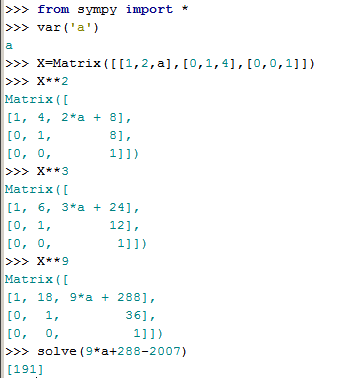It's not that tough.
If ⎣ ⎡ 1 0 0 2 1 0 A 4 1 ⎦ ⎤ N = ⎣ ⎡ 1 0 0 1 8 1 0 2 0 0 7 3 6 1 ⎦ ⎤
then find the value of ( A + N ) .
Practice the set Target JEE_Advanced - 2015 and boost up your preparation.
The answer is 200.
This section requires Javascript.
You are seeing this because something didn't load right. We suggest you, (a) try
refreshing the page, (b) enabling javascript if it is disabled on your browser and,
finally, (c)
loading the
non-javascript version of this page
. We're sorry about the hassle.
3 solutions
@Sandeep Bhardwaj @Tijmen Veltman
same way....grand presentation sir!!!upvotes!!!!
Claim: ⎣ ⎡ 1 0 0 2 1 0 A 4 1 ⎦ ⎤ N = ⎣ ⎡ 1 0 0 2 N 1 0 A N + 4 N ( N − 1 ) 4 N 1 ⎦ ⎤ .
Proof by induction:
For N = 1 the equality is clear. Suppose it holds for certain N ∈ N , then we have:
⎣ ⎡ 1 0 0 2 1 0 A 4 1 ⎦ ⎤ N + 1 = ⎣ ⎡ 1 0 0 2 1 0 A 4 1 ⎦ ⎤ N ⎣ ⎡ 1 0 0 2 1 0 A 4 1 ⎦ ⎤ = ⎣ ⎡ 1 0 0 2 N 1 0 A N + 4 N ( N − 1 ) 4 N 1 ⎦ ⎤ ⎣ ⎡ 1 0 0 2 1 0 A 4 1 ⎦ ⎤ = ⎣ ⎡ 1 0 0 2 + 2 N 1 0 A + 8 N + A N + 4 N ( N − 1 ) 4 + 4 N 1 ⎦ ⎤ = ⎣ ⎡ 1 0 0 2 ( N + 1 ) 1 0 A ( N + 1 ) + 4 N ( N + 1 ) 4 ( N + 1 ) 1 ⎦ ⎤
as desired.
Hence we are looking for A and N such that 2 N = 1 8 , hence N = 9 , and A + 4 N ( N − 1 ) = 2 0 0 7 , giving A = 1 9 1 and A + N = 1 9 1 + 9 = 2 0 0 .
good!good!upvoted!!
Log in to reply
but how u got to know that result to be proved by induction...is it by taking elementary values of n??
Since the matrix is upper diagonal it's likely to have 'magical' properties. With hopes of exploiting them I simply try forming successive powers.

I don't deserve to be so lucky! Having matched the other elements all I need to do is to solve for A in the expression in the upper right element.
Consider the given matrix as X and split it into two as given below, where I is the unit matrix of order 3 .
X = ⎣ ⎡ 1 0 0 2 1 0 A 4 1 ⎦ ⎤ = ⎣ ⎡ 1 0 0 0 1 0 0 0 1 ⎦ ⎤ + ⎣ ⎡ 0 0 0 2 0 0 A 4 0 ⎦ ⎤ = I + B
Now,
B 2 = ⎣ ⎡ 0 0 0 0 0 0 8 0 0 ⎦ ⎤ ⇒ B r = 0 ∀ r > 2
We can now use binomial expansion to find X n as all the powers of B greater than 2 can be neglected.
⇒ X n = ( I + B ) n = I + n B + 2 n ( n − 1 ) B 2 ⇒ X n = ⎣ ⎡ 1 0 0 2 n 1 0 n A + 4 n ( n − 1 ) 4 n 1 ⎦ ⎤
Now just put in given values to get answer as 2 0 0